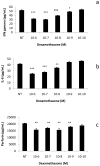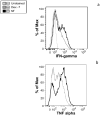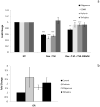Glucocorticoid dysregulation of natural killer cell function through epigenetic modification
- PMID: 20656012
- PMCID: PMC2989339
- DOI: 10.1016/j.bbi.2010.07.244
Glucocorticoid dysregulation of natural killer cell function through epigenetic modification
Abstract
It is well-established that psychological distress reduces natural killer cell activity (NKCA) and dysregulates cytokine balance. This may be mediated by stress-induced release of glucocorticoids, which have broad effects on the immune system, including the suppression of NKCA and alteration of cytokine production. The purpose of this study was to evaluate epigenetic mechanisms that may underlie the effect of glucocorticoids on NK cells, using the human NK cell line, NK92. Treatment of NK92 cells with the synthetic glucocorticoid, dexamethasone, at a concentration of 10⁻⁷M, produced a significant reduction in NKCA. Glucocorticoid inhibition was a consequence of not only a reduced capacity of the NK cells to bind to tumor targets but also a reduced production of granule constituents (perforin and granzyme B) with no detectable effect on granule exocytosis. Glucocorticoids also reduced the constitutive and the stimulated production of the cytokines, IL-6, TNF alpha and IFN gamma, and reduced the surface expression of LFA-1. Glucocorticoid treatment also reduced global histone acetylation, the acetylation of histone 4 lysine position 8, and the accessibility of the proximal promoters of perforin, interferon gamma and granzyme B. Histone acetylation was recovered by treatment of the NK cells with a histone deacetylase inhibitor, which also restored NKCA and IFN gamma production. These results demonstrate glucocorticoids to dysregulate NK cell function at least in part through an epigenetic mechanism, which reduces promoter accessibility through modification of histone acetylation status. This epigenetic modification decreases the expression of effector proteins necessary to the full functional activity of NK cells.
Copyright © 2010 Elsevier Inc. All rights reserved.
Conflict of interest statement
All authors declare that there are no conflicts of interest.
Figures





References
-
- Adcock IM. Glucocorticoid-regulated transcription factors. Pulm Pharmacol Ther. 2001;14:211–219. - PubMed
-
- Alexandroff AB, Robins RA, Murray A, James K. Tumour immunology: false hopes--new horizons? Immunol Today. 1998;19:247–250. - PubMed
-
- Almawi WY, Melemedjian OK. Molecular mechanisms of glucocorticoid antiproliferative effects: antagonism of transcription factor activity by glucocorticoid receptor. J Leukoc Biol. 2002;71:9–15. - PubMed
-
- Alter G, Malenfant JM, Altfeld M. CD107a as a functional marker for the identification of natural killer cell activity. J Immunol Methods. 2004;294:15–22. - PubMed
Publication types
MeSH terms
Substances
Grants and funding
LinkOut - more resources
Full Text Sources
Medical

